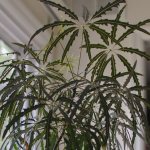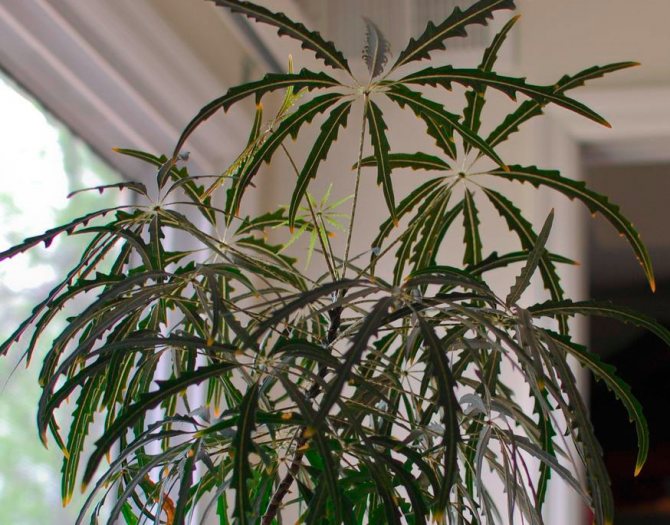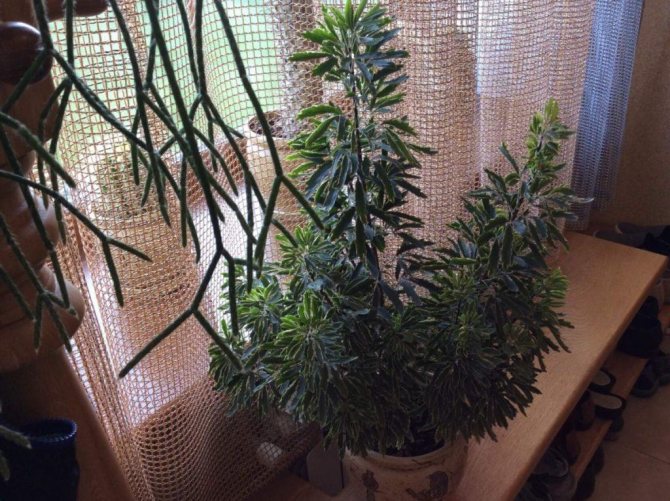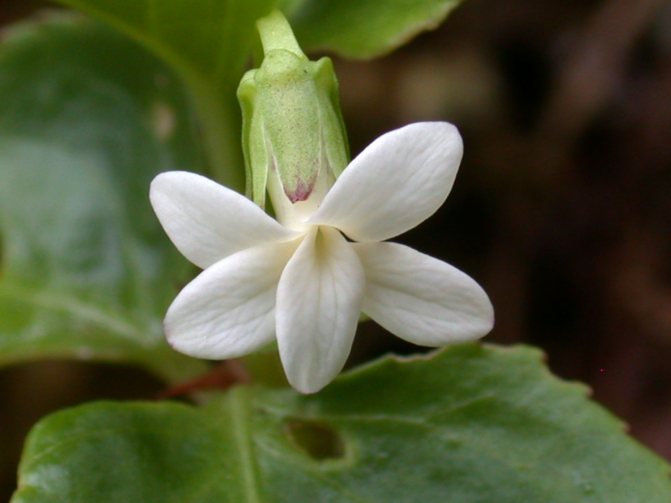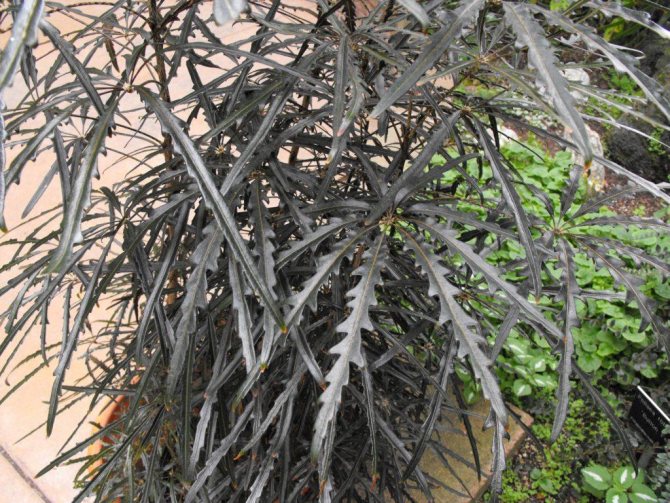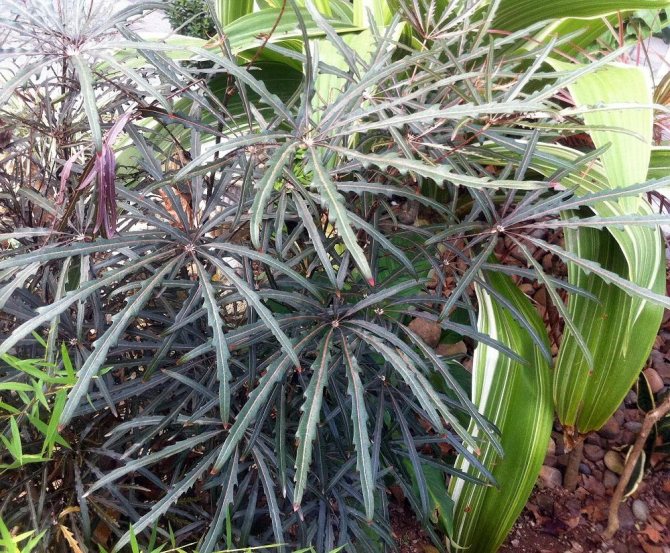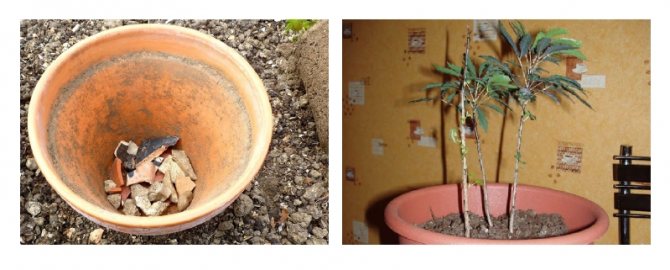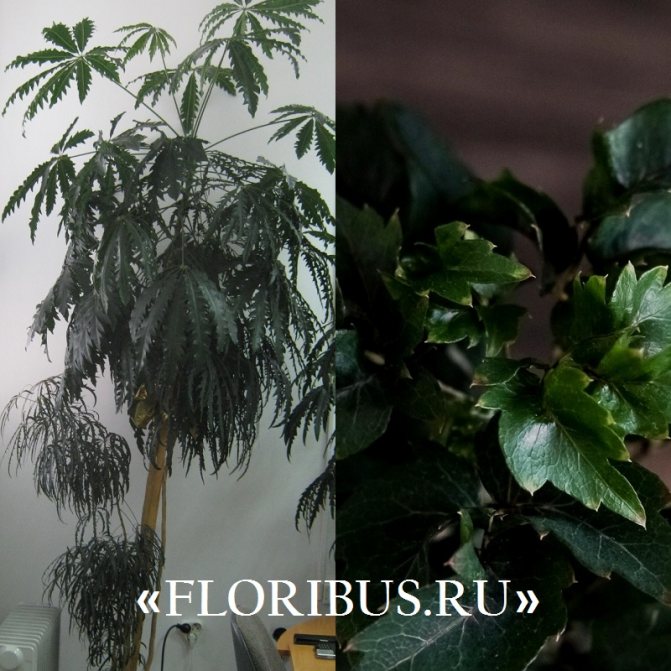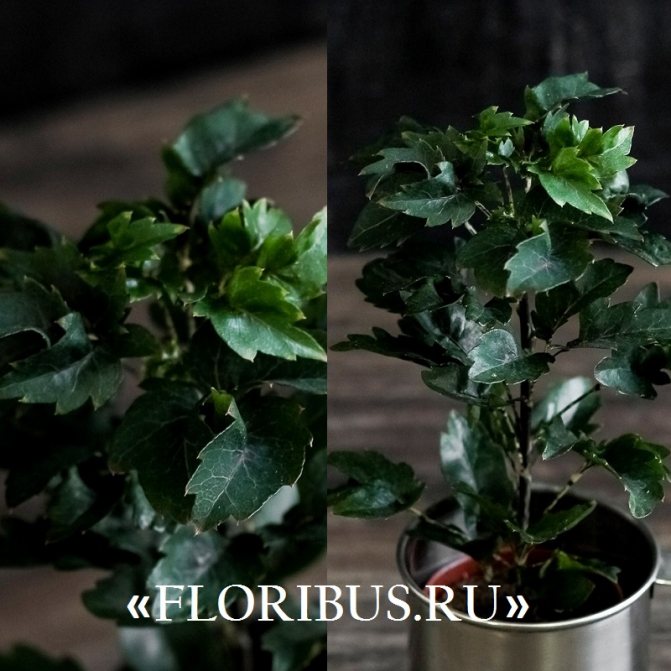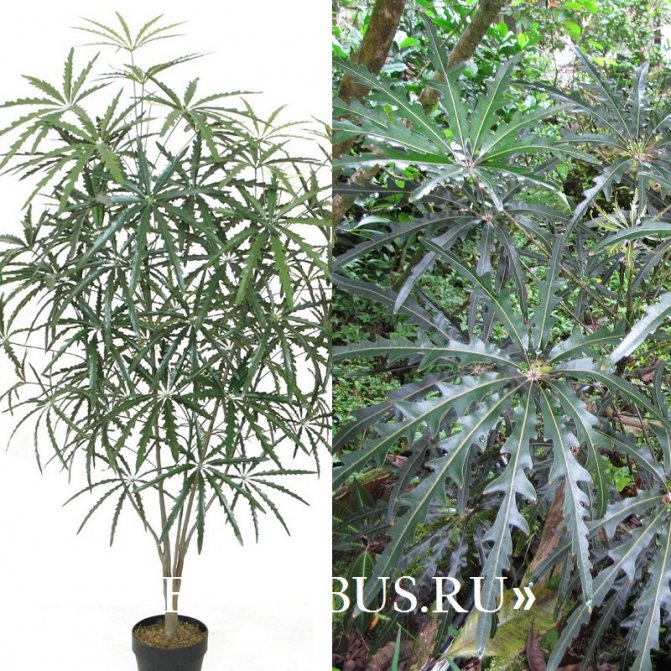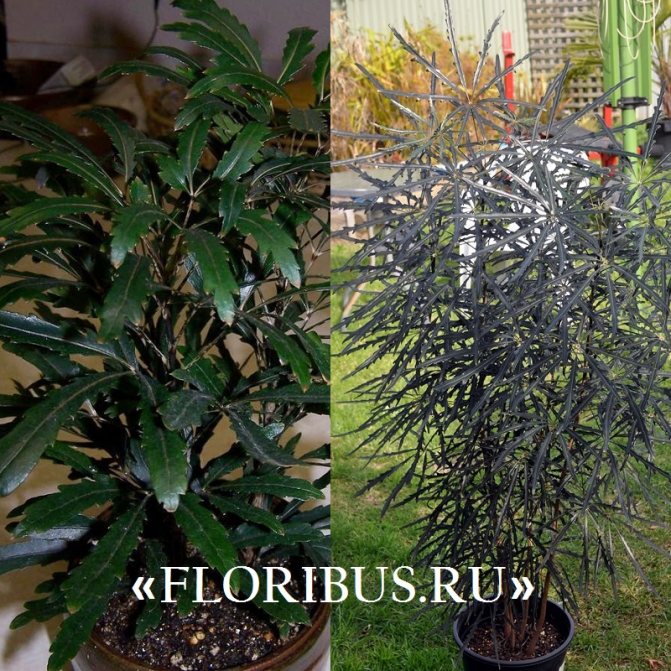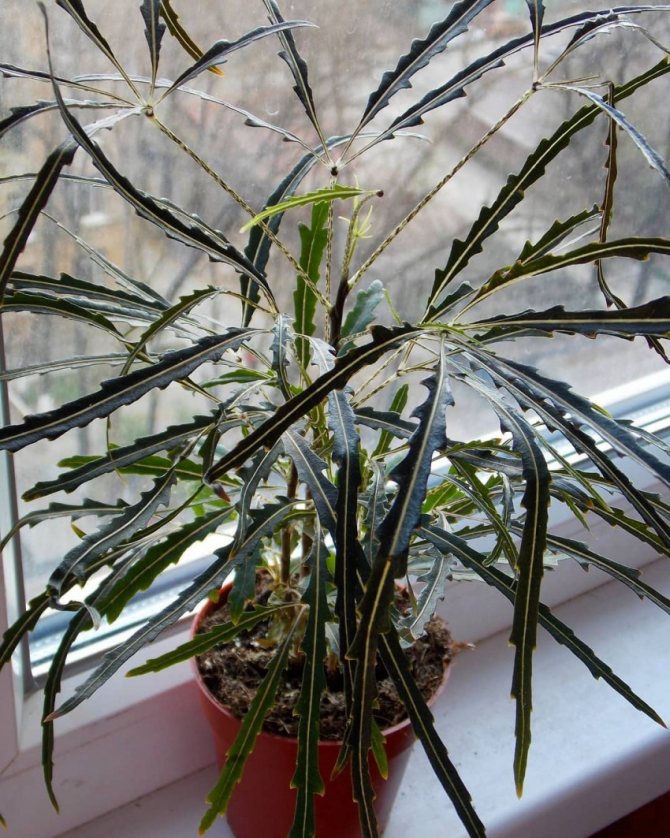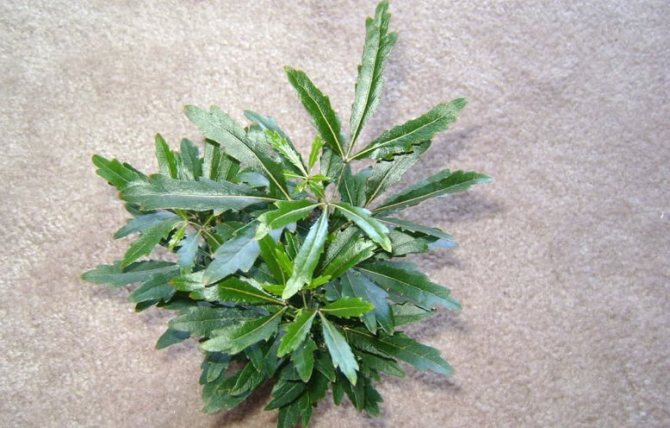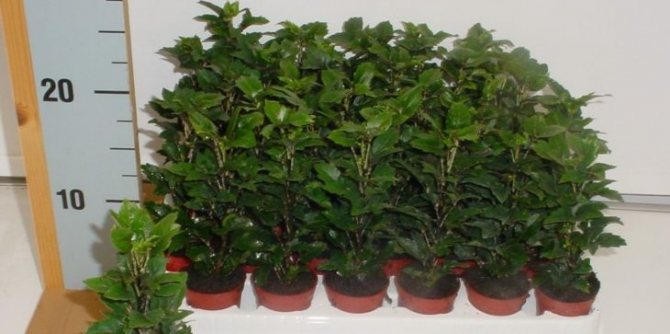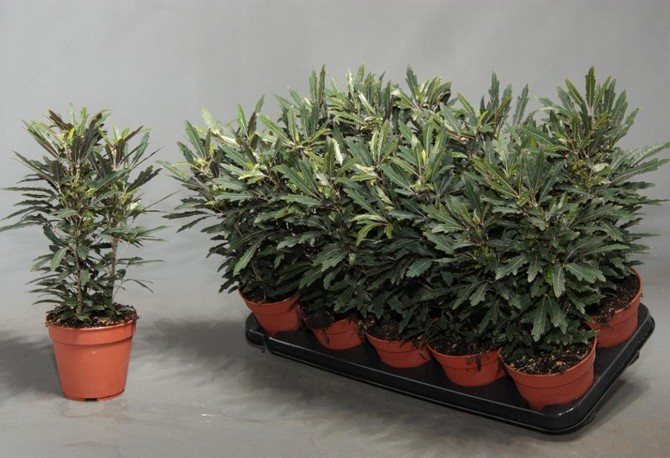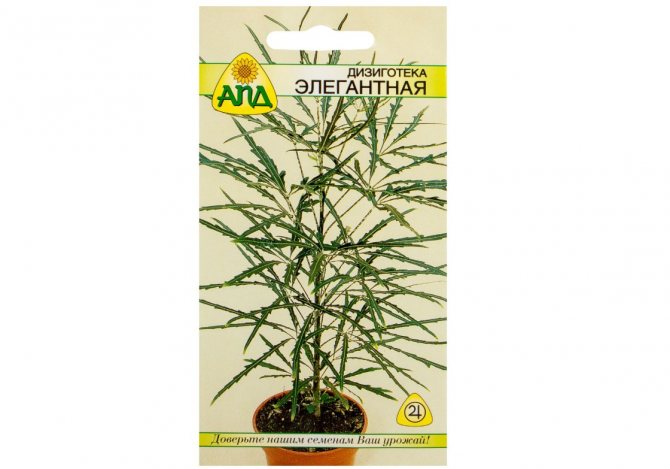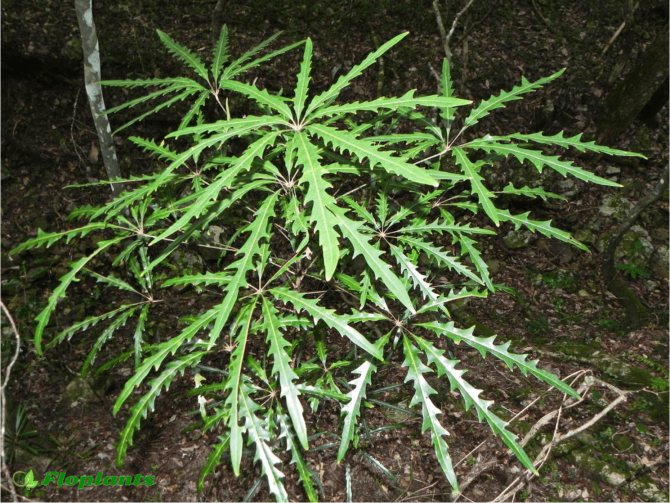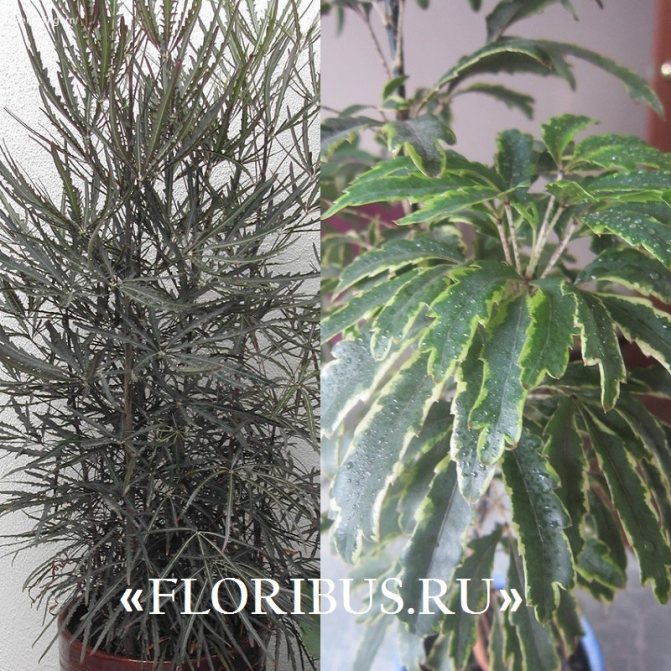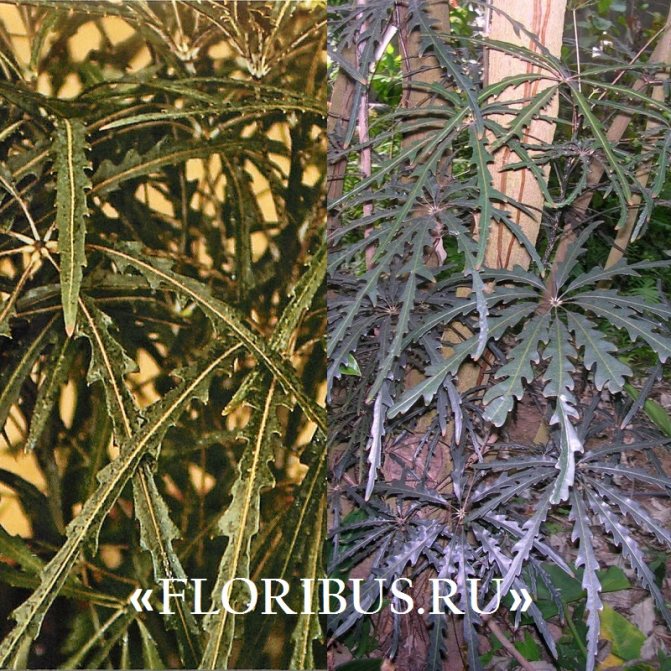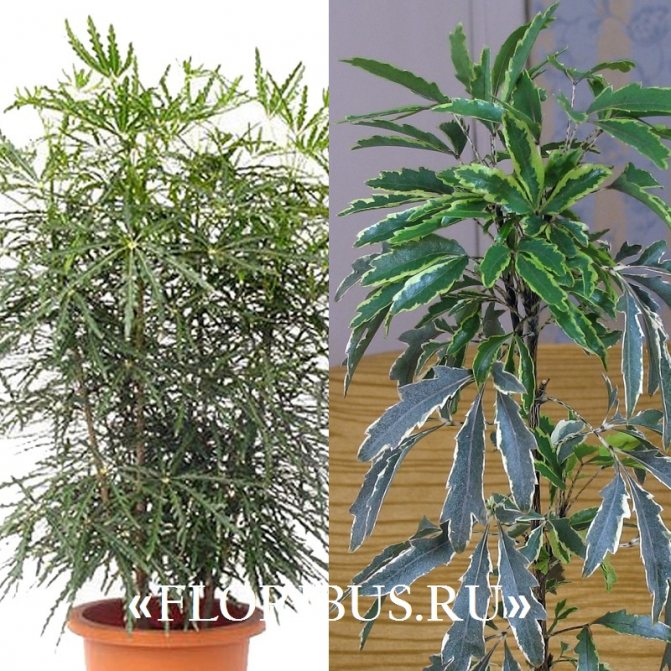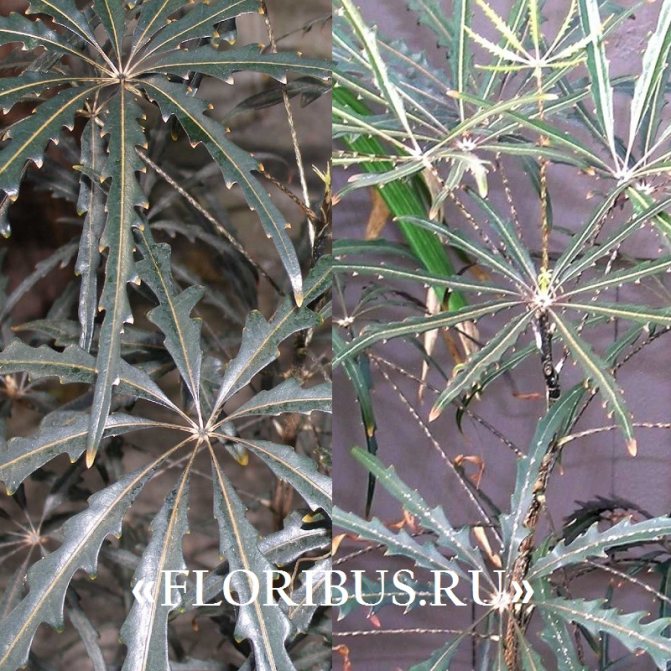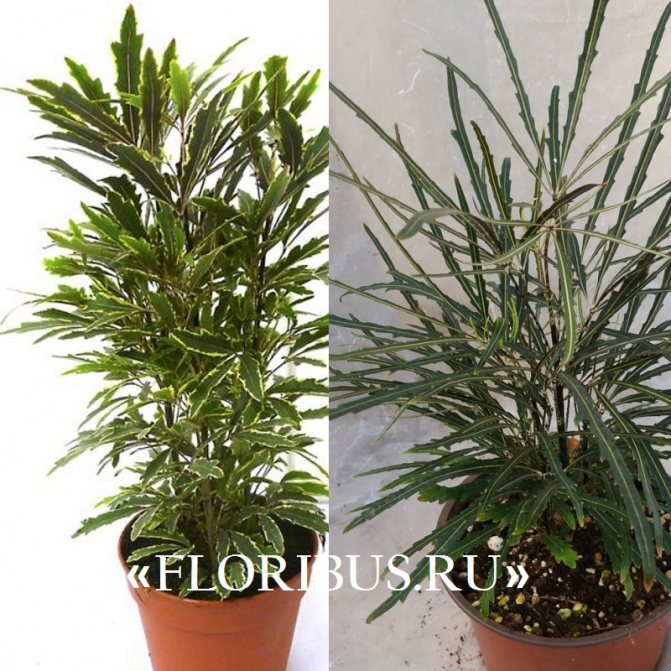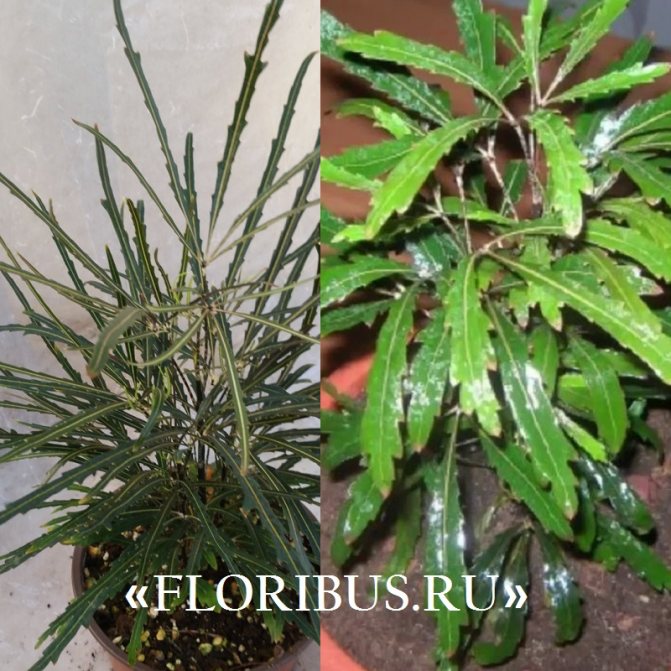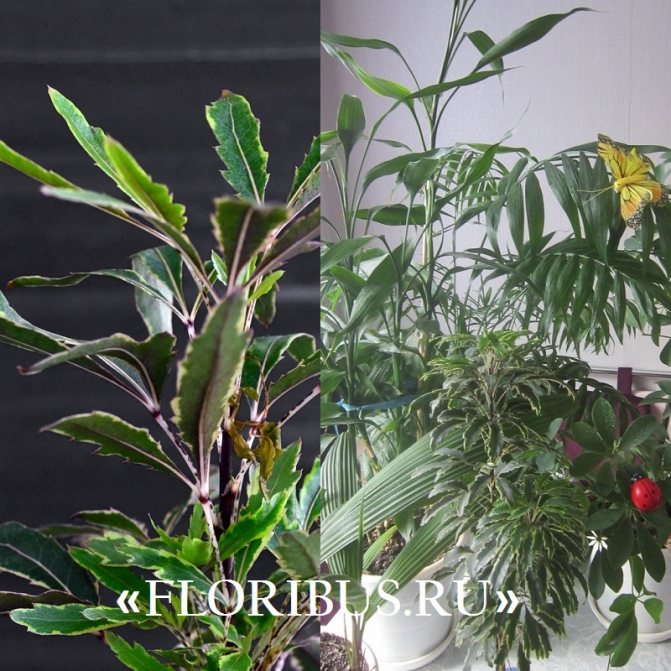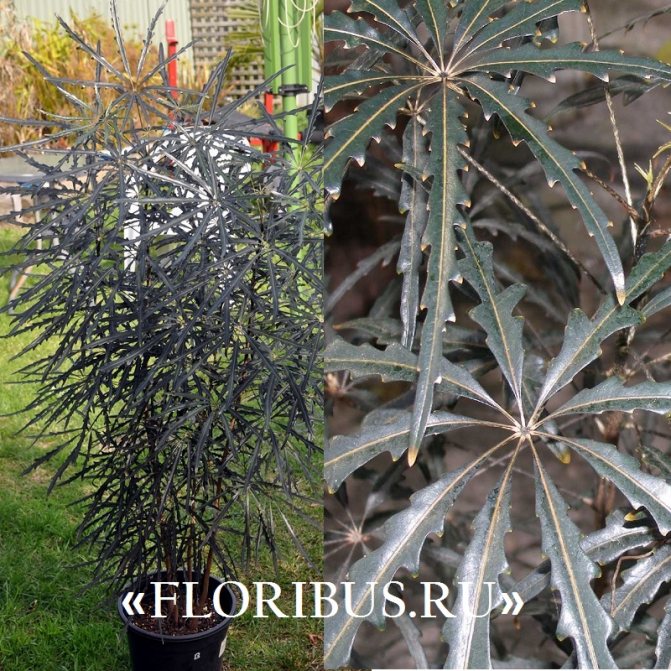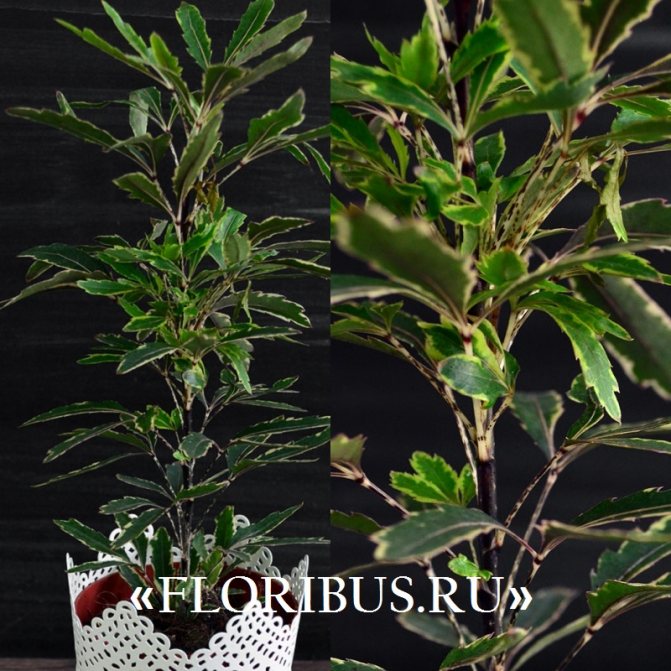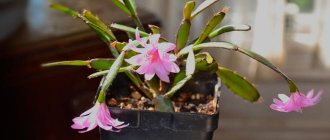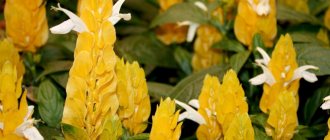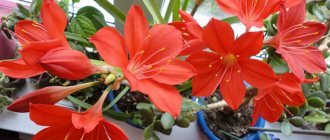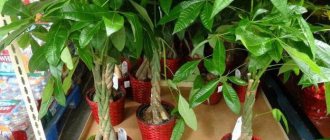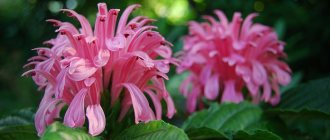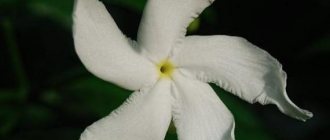The birthplace of the dizigoteka is considered to be small islands in the South Pacific Ocean. Polynesian climatic conditions differ significantly from ours, which complicates the process of creating optimal factors for plant growth. High humidity, moderate temperatures and adequate ambient lighting are the keys to the success of growing a dizigoteca at home.
| High growth rate. |
| Dizygoteka almost never blooms at home. |
| The plant is easy to grow. |
| Perennial. |
Dizigoteka
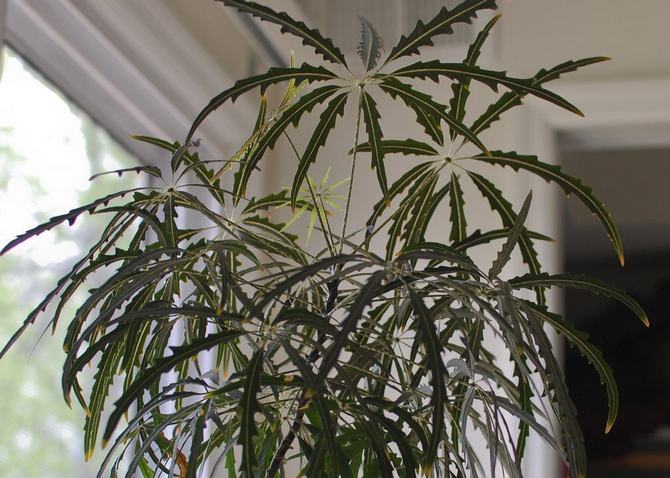
Dizygotheca (Dizygotheca) from the genus Araliaceae (Araliaceae) is appreciated by lovers of indoor flowers for the decorativeness of the leaves. A shrub plant with evergreen foliage, it came to our latitudes from distant Australia and the islands of Oceania.
Small flowers of the dizigoteca, woven into an umbrella, are not of particular aesthetic value, but its foliage is quite beautiful. The leaves are composed of several jagged segments and resemble spread fingers. Their color varies in different varieties from copper shades to charcoal.
Interesting facts about dizygotek
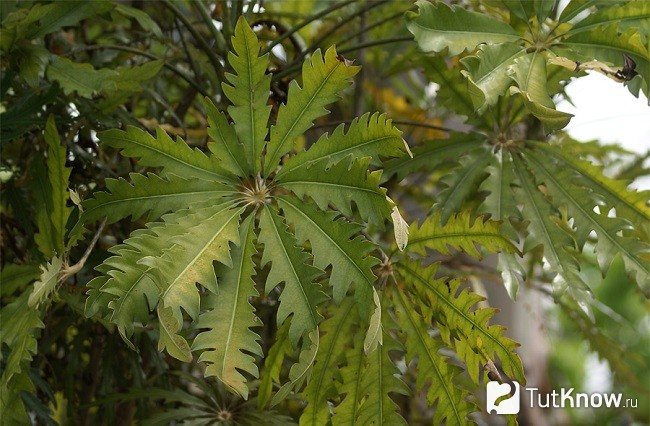

At the moment, the genus Dizigoteka has been abolished and its botanical name has changed to Schifflera elegantissim, although the leaves of the species are slightly different.
The most famous of the "relatives" of the dizigoteca is ginseng. Flowering does not occur under indoor growing conditions. The main supplier of this openwork plant is the Netherlands.
Dizygoteka care at home
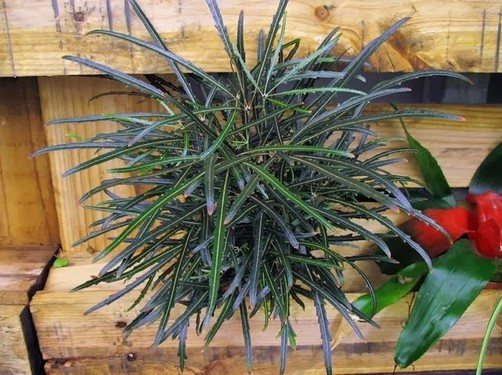

Location and lighting
Dizygotics is very fond of light at any time of the year, it will even endure the scorching summer rays of the sun, but not at the very zenith. Still, it must be protected from the midday summer sun.
In winter, you need to choose the most lighted windowsill for a plant, especially when it is in a room with a temperature of more than 18 degrees. Then it also needs additional lighting. In summer, dizygotics will feel great in the fresh air, but in a place protected from burning rays.
Temperature
In spring and summer, the flower does not really like the heat: its temperature optimum is 20 degrees. The winter range varies from 16 to 18 degrees, and the lower threshold for the content is 15 degrees. Dizygotics does not tolerate proximity to heating systems that drain everything around.
Air humidity
Because of its love for moisture, the flower has become increasingly common in the florarium. An indispensable condition for the successful cultivation of a dizigoteca is regular spraying. Winter heating forces you to resort to such methods as evaporation of moisture from a sump filled with water with expanded clay or sphagnum.
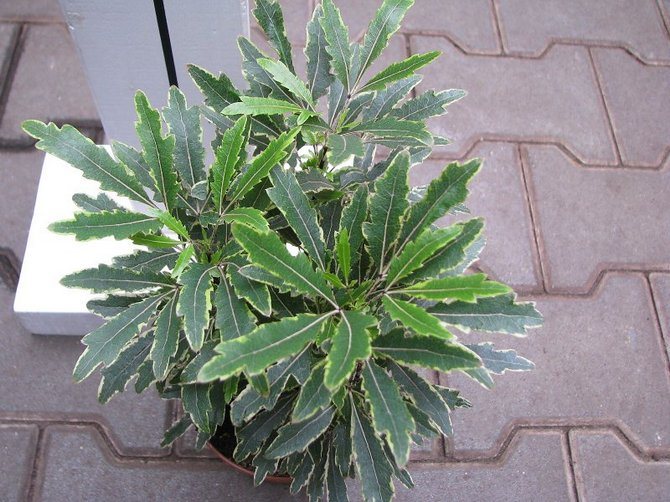

Watering the plant in spring and summer is necessary in sufficient quantities, however, overflows should not be allowed, as well as strong drying of the soil in the pot.Water should be at room temperature and separated for at least 12 hours. Autumn cooling means a decrease in the amount of moisture in the soil. In winter, watering the dizygotek is necessary only to prevent overdrying, especially at low temperatures.
Top dressing and fertilizers
Every week in the summer, use a special feed for plants with decorative leaves for the dizigoteka.
A spring transplant is required to arrange a flower annually or every 2 years. The optimal composition of the soil is expressed in 2 parts of sod for 1 part of humus and sand. Don't forget good drainage.
Transfer
Transplanting a dizigoteca should be done when the roots from the drainage hole begin to creep. This must be done.
A large ceramic flower pot should be 1.5 times larger than the old one. For transplantation, it is necessary to prepare a substrate that is lighter and richer in organic matter. It is imperative to add drainage (to the bottom of the pot), sand, peat and humus, and the sod land should be 2 times more. It is recommended to transplant once every 3 years or a little less often.
Reproduction of a dizigoteca
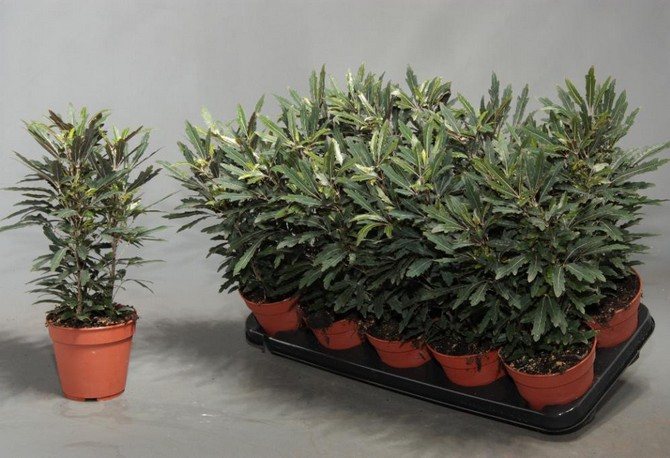

Seed propagation
It is better to sow dizigoteka seeds at the end of winter. Before that, it would not hurt to soak them in a stimulant solution. In loose earth, you need to bury the seed at a distance equal to two of its lengths. It is better to moisten the soil with seeds from a spray bottle and keep it warm, not lower than 20 degrees, but not higher than 24. The container covered with transparent glass or film should be periodically ventilated and moistened.
Additional heating from below will help speed up the seed germination process. Young sprouts, which already have 2-3 leaves, are planted in separate cups and grown for several months at 18-20 degrees. Then, more mature seedlings are transferred in two stages into larger pots, and the temperature of the content is lowered each time by two degrees.
Propagation by cuttings
The cut offshoots of the dizigoteca are difficult to root, so they should be treated with a special root former. After that, plant the cutting in a mixture with 50% sand and the same part of peat. Cover with transparent material and place in a bright place. Further care for them will be the same as for the growing seedlings: rooting under the can, the gradual removal of the shelter and transplantation as the root system grows with a gradual decrease in the ambient temperature.
Important! When working with a dizygotek, do not forget about gloves, since all of its components contain poison. Keep the plant out of reach of children and pets.
Reproduction
The dizigoteka is seated in two ways:
- Propagation by cuttings is the most practical and acceptable way. They can be separated both in summer and in spring (there must be at least 2 pairs of adult leaves). You need to keep them in one of the solutions: zircon, root, heteroauxin.
After planting the cuttings, cover the pot with a bag or jar and put it in a permanent place with weak diffused lighting. Periodically, you need to ventilate the pot and spray the ground. You can transplant a dizygotek after the earthen coma is completely entwined with roots.
- Good times to plant seeds are January and February. Soak them in warm water using a growth stimulant. They are embedded to a depth of 1 cm in a pre-moistened substrate.
Before seed germination, the container should be kept covered with a film, which contributes to their rapid germination. You can transplant the plant into a pot when several leaves appear.
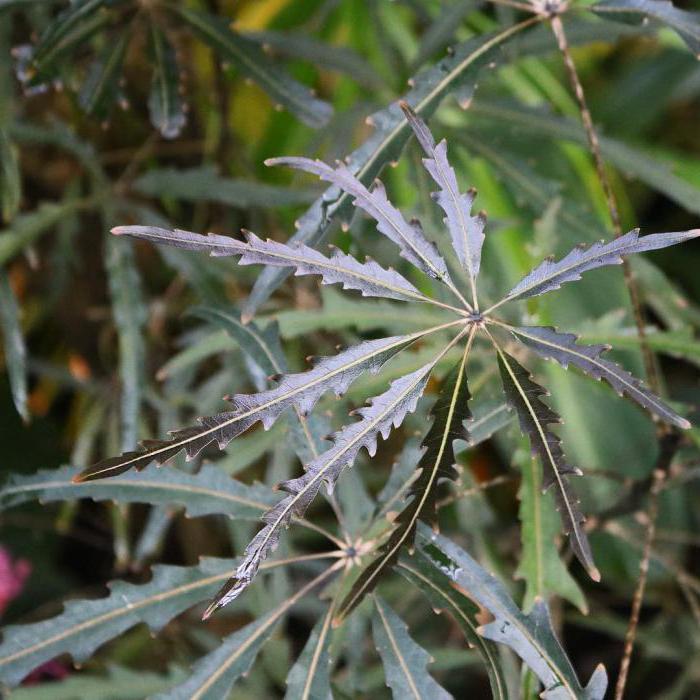

Diseases and pests
Spider mites, thrips, and scale insects are frequent uninvited guests that harm the leaves and roots of the dizigoteca.
How do plant diseases manifest themselves and what is their cause?
- Loss of lower foliage - little light.
- Whitish bald patches on the leaves, turning brown over time - direct hits of rays.
- The flower grows poorly, its leaves have become small - there is little nutrition in the soil.
- Loss of foliage - temperature violations, dry air, drafts or proximity to heating appliances.
Care and cultivation of a dizigoteca
In culture, the plant is found infrequently and this is largely due to its capricious disposition. In her homeland, she is used to growing in the comfortable conditions of an eternal "velvet" summer, when the air temperature, due to the proximity of the ocean, does not drop below +19 degrees and does not rise above +26 degrees, with a constantly high relative humidity and almost the same daylight hours during the whole year. In ordinary apartments, it is hardly possible to recreate such a microclimate, but it would be an unforgivable mistake to ignore the corresponding requirements of the dizigotek for the conditions of detention.
The soil for growing such an overseas sissy needs light and loose, moderately nutritious with a neutral or slightly acidic reaction. The easiest way is to purchase ready-made soil in stores, intended, for example, for begonias, Saintpaulias or Dracaena. You can prepare a substrate for growing yourself by mixing two parts of leaf and humus soil with sand and peat (2: 2: 1: 1) or turf soil with humus and sand (2: 1: 1). The bottom of the pot must be lined with a drainage layer.
The capacity is chosen depending on the volume of the root system, but, as a rule, small standard sizes. Young specimens can be grown in double pots for a more comfortable microclimate.
The dizygoteka is less demanding for illumination than for humidity and temperature conditions. It is even considered to be a moderately shade-tolerant plant and is often located in the back of the room. But it will grow best of all near windows facing west or east. On the south - at the peak of solar activity - shading may be needed, and on the north - artificial lighting. Additional lighting is also necessary in winter with an increase in the length of daylight hours.
Dizigoteka is very thermophilic and will feel uncomfortable already at a temperature of +18 degrees, and cooling the soil by another 3-4 degrees can lead to death. Drafts and sudden temperature changes are also detrimental to her. There is no clearly expressed dormant period in the life cycle of a dizygoteque. But in winter, especially if it is not possible to provide a sufficient level of lighting, you can slightly reduce the frequency of watering and do without top dressing.
The dizygotek is watered each time so that excess moisture flows into the pan. But the topsoil should dry out slightly between waterings. The dizygoteka needs more than watering in high air humidity. Therefore, very frequent and regular spraying is needed. Water in both cases is used only soft, settled at room temperature. When spraying is not enough, you can put the plant pot on a wide tray with expanded clay or wet sawdust, and if a double pot is used, then the inside of it can be filled with wet moss.
In order for the foliage of the dizigoteka to be thick, lush and pleasing to the eye, regular feeding is necessary, for which it is best to use ready-made liquid universal fertilizers intended for decorative deciduous crops. It is recommended to introduce them simultaneously with watering once every two weeks. Once a month, the plant can be pampered with pure organic matter - infusion of mullein, diluted in a ratio of 1:10 or bird droppings (1:20). It is good to alternate root dressing with foliar.
The root system of the dizigoteca, even during the period of its active growth, weakly increases in volume, therefore, it is enough to transplant once every two to three years,and in adult specimens, only change the upper soil layer 3–5 cm deep.
As a rule, it does not need pruning, but it tolerates it well, therefore, for decorative purposes, you can safely get rid of leaves starting to dry out or young shoots growing inside the crown.
Popular types of dizigotek
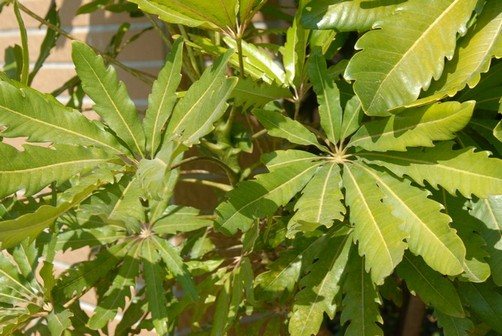

The most popular are two of its types: Dizigoteka elegant and Dizigoteka Veich.
Dizygotheca elegant (Dizygotheca elegantissima)
This species has a straight trunk, like a tree, but without pronounced branching. Oblong leaves, serrated along the edges, are located on elongated stems and have a rich green color. Attached to each stem are 4-11 of these leaves, looking in all directions in a circle. Umbrella inflorescence is located at the top and consists of nondescript flowers.
Read also: Why lilacs don't bloom: reasons and what to do
Dizygotheca veitchii
Evidence, she practically does not differ from the previous representative. This dizigoteca is tree-like with evergreen leaves, only their carved edge is smoother, bending in a wave.
Is dizigoteka toxic
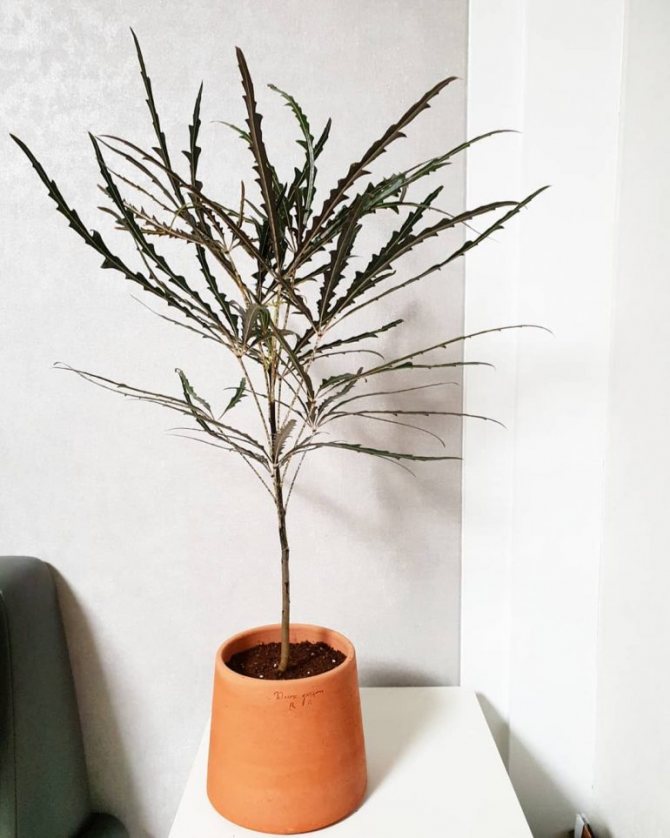

Dizigoteka elegant (graceful). Photo
The exotic culture is distinguished by its attractive appearance: spreading umbrellas with elegant jagged leaves rise above the bush. There are no thorns or needles on them. Touching them does not cause redness or swelling. But you shouldn't taste the greens or let the juice get on the cuts. Research carried out has not proven the plant's safety.
Origin and description
An evergreen shrub plant, a representative of the Araliev genus. In the wild, dizigoteca is common on the islands of Oceania and in Australia. It is grown here as an ornamental deciduous indoor crop.
Growers are interested in large expressive leaves. Consist of several shares. The shape of the leaf is often compared to spread fingers. The edges of the segments are serrated. Coloring - from copper to dark, almost black. The flowers are small, collected in an umbellate inflorescence. They have no decorative value.
Top dressing
Feed dizygoteku is recommended twice a month from spring to autumn, alternating organic and mineral fertilizers.
We have prepared an interesting article for you about the poisonous plant dieffenbachia.
Types for home cultivation
As a home culture, only one variety is used - the elegant dizygotheca, or elegantissima (Dizygotheca elegantissima). She is more familiar to some under the name "shefflera" or "aralia". In nature, it grows in the form of a large tree up to 8 meters high and a crown up to 4 meters. In a confined space, growth is inhibited. Home dizigoteca elegantissima grows no higher than 2 meters.
Shoots grow straight up. The leaves are divided into 7-10 equal lobes. The length of each lobe reaches 30 cm, the width is 2 cm. The shape of the leaf is thyroid, rounded. Contrasting color - light veins on a dark background. The length of the common petiole is up to 40 cm. The color of the petioles is light with a grayish tinge. It blooms with pale green flowers in late summer or September. After the end of flowering, the fruits ripen - round berries of dark brown color.
On the basis of the species, breeders have bred interesting varieties with an original color and shape of the leaves. The following varieties are most often found in flower collections.
- Dizigoteka Bianca. The leaves are divided into 3-5 lobes, variegated. The veins are light purple, the edge is white.
- Dizigoteka Gemini. Differs in ovoid leaf shape. Divided into 3-5 wide lobes with a coarsely serrated edge. The color is dark green.
- Dizigoteka Castor. The leaves are not large, consist of three short lobes up to one and a half centimeters wide. The edge is covered with rounded teeth. The color of the leaves is dark, yellow veins stand out against its background.
Disigoteca varieties
There are several varieties of dizigoteka:
- Elegantissima - straight shoots without branching. The leaves have a rich green color, have an oblong shape and large serration at the edges.
- Castor - the leaves are distributed into three parts 9 cm long and 1.5 cm wide. The teeth are slightly rounded at the edges, and light veins run along the dark green leaves.
- Bianca - the structure of the leaves is similar to the previous variety. The color of the plate is dark green with a white border and purple veins.
- Gemini - This plant has an ovoid leaf shape with large serrate lobes. The foliage is dark green with burgundy elements at the tips of the teeth.
- Veicha - the leaves have a light green color and wavy edges.
- Gracillima is the shortest species. The leaves are wider than other varieties and have wavy edges. The color of the leaf plates is bright green, the veins on them are not pronounced.
- Kerkhova - similar to Veitch, but with a paler shade of leaves.
The most common and unpretentious is the elegantissima dizigoteka. This variety takes root best in modern apartments.
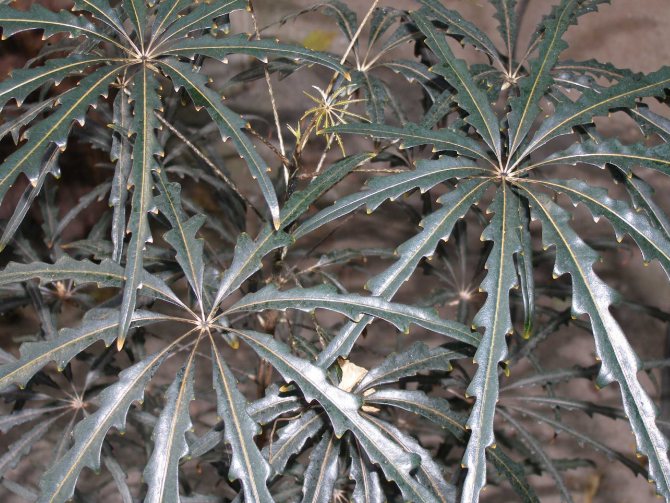

Dizigoteka elegantissima
Care features
To understand how to care for dizygoteka at home, to find an approach to it, it is enough to analyze the natural microclimate of its habitat.
- Lighting and site selection. At any time of the year, they are kept in bright light. Placed on the south window. It is not afraid of the sun, but in the very heat it is slightly shaded. A plant standing in partial shade is not placed in the sun right away - it is taught gradually. There is a great need for light in winter. At temperatures above 18 ° C, additional artificial lighting is provided. In the summer they are taken out into the fresh air.
- Temperature. The optimum temperature is around 20 ° C. With the onset of winter, it is reduced to 16-18 ° C. Do not drop below 15 ° C. It is not recommended to place it next to radiators and other heating devices.
- Watering. It reacts equally negatively to excess and lack of moisture. The soil is kept moderately moist, watered as needed. Do not use cold hard water. It is preliminarily defended for 12-24 hours. As the room temperature drops, the moisture requirement decreases. In winter, watering is supportive in order to prevent the soil from drying out.
- Humidity. For high decorativeness, high-grade growth, high humidity is needed. Sprayed regularly, the pot is placed on a tray with water and filler - pebbles, expanded clay, hydrogel, sphagnum. Dizygoteka grows well in florariums.
- Top dressing. Any liquid complex fertilizers are suitable. The dosage of any drug is halved. Fertilizers are applied only after preliminary watering.
- Transfer. Depending on the intensity of growth at intervals of 1-2 years. The optimal composition of the substrate is turf, humus and sand. The composition is dominated by turf. The bottom of the pot or tub must be covered with a thick drainage layer.
Growing conditions indoors
Dizygotek should not be in direct sunlight. In very bright light indoors, the leaves become small and darken. The dizigoteka is very demanding on good lighting and clean air. Caring for it at home requires a lot of attention, but it is not difficult for experienced florists.
The acceptable temperature on summer days for growing this plant at home is from +20 to +24 ° C. Dizigo does not like very hot weather. In winter, + 15 ° C is enough for her, but if possible, it is better to keep the temperature within + 16-18 ° C.
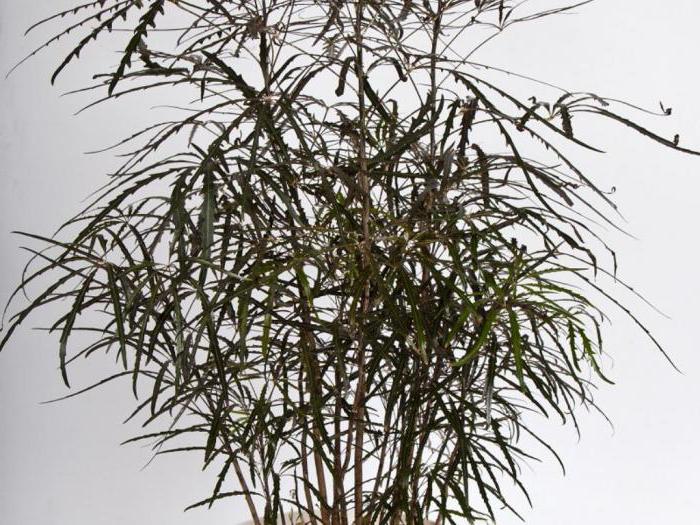

Reproduction methods
Difficulties can arise when multiplying a dizigoteca. Florists practice two methods.
- Sowing with seeds. Seed material purchased from specialized stores is used. Seed germination is low - it is recommended to sow with a margin.A good time for sowing is the end of winter. Before planting, the seeds are soaked for several hours in a solution of heteroauxin or another stimulant. Sow in a moist light substrate at a shallow depth. Keep under cover at moderate temperatures no higher than 24 ° C. The surface of the substrate is regularly sprayed with a spray bottle. Short airing is arranged daily. The bottom heating accelerates the germination process. Seedlings are planted at the stage of 2-3 true leaves. Keep in a cool room 18-20 ° C. After 3-4 months, the seedlings are transferred to larger pots.
- Cuttings. Cuttings are hard to root. Special root formers (heteroauxin, Kornevin) increase the likelihood of root formation. The shoots are cut off, treated with a root former, planted in a mixture of peat and sand. They are kept in the light, under cover. The greenhouse is ventilated daily, moistened as the substrate dries up. The appearance of signs of growth will indicate successful rooting. They do not transplant immediately - they wait for the development of the root system.
Read also: We create a waterfall with our own hands for a summer residence
Do-it-yourself flower propagation rules
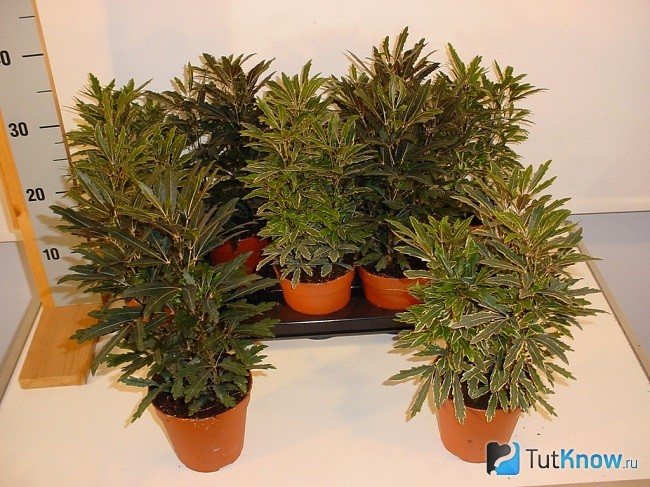

It is very difficult to get such a bush at home, therefore, flower growers who want to acquire a dizygotek simply buy a finished plant, but there are enthusiasts who are ready to experiment and try their hand at this difficult task.
The method of cuttings is used, when cuttings are cut from the tops of the shoots. The difficulty lies in the fact that it will be necessary to carry out the bottom heating of the soil in the container with plantings. And the cut of the branch before planting is recommended to be treated with a root formation stimulator (for example, Kornevin). Cuttings should be cut from healthy shoots so that the length varies between 7-10 cm. The cut is made directly under the knot, using a sharpened knife, which was previously disinfected. The lower leaves from the branches must be removed, the cut is treated with a stimulant, the remains are shaken off and planted in a moistened prepared peat-sand substrate, crushing the soil around the cutting. The planted branches are covered with a glass jar or wrapped in plastic wrap - this will create the conditions for a mini-greenhouse.
The pot with cuttings is placed in a warm place (the temperature should not go beyond 22-25 degrees). It is important not to forget to regularly ventilate and moisten the soil in a container if necessary. When the first shoots appear, this will be evidence that rooting was successful. After that, they begin to take off the shelter little by little, leaving the seedlings for a longer time without it, so that young dizigotecs get used to the conditions of the room. After some time, you should transplant into small pots with a diameter of 7-9 cm and a selected substrate.
If reproduction is carried out with the help of seeds, then this operation is performed in the spring. And be sure to use a mini-greenhouse or just put crops under glass. An earth mixture (peat-sandy soil) is poured into the container and seeds are sealed to a depth of 1 cm, they are sprayed from a finely dispersed spray bottle with warm, settled water. The container with crops is placed in a warm place with diffused lighting. When the first shoots appear, the shelter is removed and the container is transferred to a brighter place, but without direct sunlight. When the seedlings grow up and a couple of leaves appear on them, then transplantation is carried out in separate pots with a diameter of 7-9 cm with suitable soil.
Botanical description
This plant is from the genus of evergreen trees and shrubs of the Araliev family. Its natural habitat is New Caledonia and Polynesia. Hot tropical forests, where the dizigoteka came from, do not let the sun's rays through.
Outwardly, the dizigoteka very much resembles a palm tree with its bare high trunk and a spreading lush crown, the diameter of which reaches 4 meters.
In nature, it can grow up to 6-8 meters in height. At home, you can grow a two-meter-tall tree with an erect stem, which lignifies over time.
The main decoration of the dizigoteca is represented by its leaves, large, palmate, divided into lobes and arranged like an umbrella. In length, each of them grows up to 30 centimeters, with jagged edges. They will be connected by a large petiole reaching 40 centimeters in length.
The color of the leaves can be copper-red or dark green, sometimes almost black, with streaks of a lighter tone. In some varieties, the edges of the leaves are lightened, which makes them even more attractive and original.
Umbrella-shaped inflorescences are made up of small, nondescript flowers. At home, flowering usually does not occur.
It is very important to note that absolutely all parts of this beautiful ornamental plant, unfortunately, are poisonous. If there are small children or pets in the house, then you need to think carefully before bringing this beauty home. And be sure to identify the plant in a place inaccessible to them.
This type of araliaceae is represented by the following varieties
Dizigoteka elegant
This is a tree-like evergreen plant, which also has a name - elegant aralia. Its leaves are rather large, dark green in color, palmate-complex, their jagged edge is not so pronounced. The petioles are long, reaching 30 centimeters. The stems are rather weakly branched. Small flowers are collected by umbrellas at the top of the inflorescence.
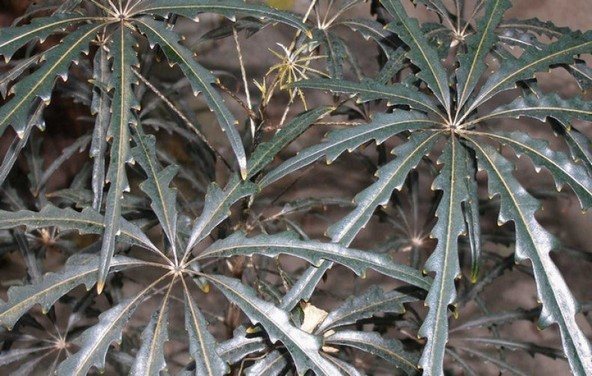

Dizigotek Veitch
Has some similarities with the elegant dizygotek. However, in this species, the leaf plates are wider and shorter. At the edges of the leaves, there are no jags, they have a wavy shape. The color varies from light green to very dark.
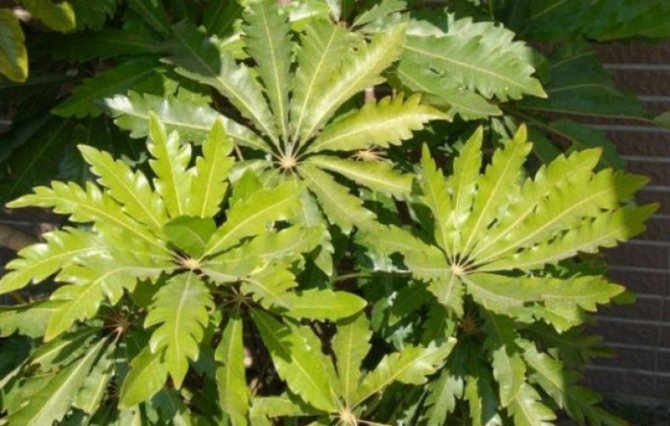

Dizigoteka Kerkhova
Similar to Veitch's similar look, but with lighter leaves.
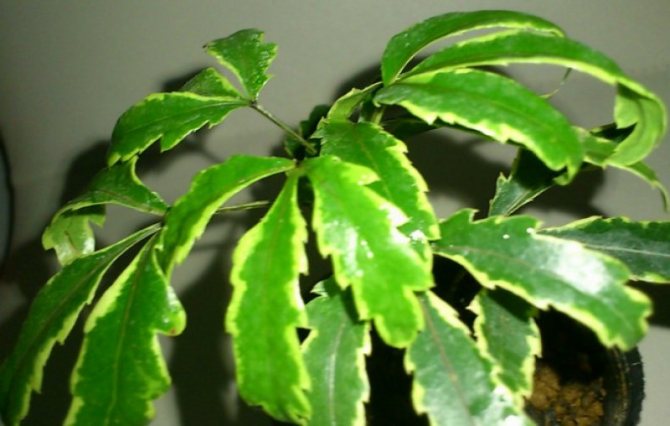

Pests
Common pests dizigoteca: scale insect, spider mite. Atypical diseases:
- Leaves dry and fall - low temperature, drafts, drought, dry air.
- Roots rot - waterlogging of the soil.
- The lower leaves are falling - bad light.
- On the leaves appear light and brown spots - sunburn.
- Leaves wither - waterlogging of the soil.
- Leaves turn pale and wither - too much light.
- Appeared on the leaves white bloom - watering with hard water.
- The plant grows poorly and produces small leaves - lack of nutrients.
What to say, grow a dizygotek only a diligent florist can do. It takes a lot of work and effort to turn her into a real beauty decorating the house with luxurious lace foliage.
And for the most curious, we suggest that you read the video about the dizygotek
Home care
For this tropical beauty, the growing conditions are high humidity and warm bright sun. When growing it at home, you should create conditions that are closest to the natural habitat of the dizigoteca.
A soft diffused light is required for a dizigoteka. Direct sunlight negatively affects development, in a very brightly lit room, the color of the leaves becomes darker, and the leaves themselves become small. In such cases, it is necessary to shade the plant a little, covering the window with a film.
The sultry scorching sun can burn delicate leaves, while they lose their elasticity and wither.
For this plant, the best place would be the western or eastern side, where there is no bright midday sun. But if the window is on the north side of the house, then you cannot do without additional illumination.
It is also important to highlight the plant when there is a lack of light in cloudy weather and on short winter days.
Temperature
Sudden changes in temperature can be detrimental to the delicate tropical plant. For him, the temperature conditions should be approximately the same at any time of the year.
In summer, the condition for comfortable maintenance will be +18 22 degrees, in hotter weather, the soil may dry out quickly, the plant will suffer from a lack of moisture. In winter, the temperature should not be allowed to drop below +16 degrees.
Since this beauty is very thermophilic, lowering the soil temperature by at least a couple of degrees relative to the usual temperature regime can lead to severe stress, it can even destroy the plant.
In winter, keep the palm away from radiators and cold window panes.
Difficulties in the growing process
| Leaves wither, wither | Waterlogging of the soil | They ventilate the room well, temporarily stop watering. If necessary, transplanted into another soil with good drainage. |
| Drying the leaves | Lack of moisture or excess sunlight | The flower is transferred to a cooler place, the irrigation regime is adjusted. |
| Leaves turn pale, shrink | Nutrient Deficiency | Feeding is carried out with a complete mineral complex. |
| Darkening and drooping of leaves | Cold | In winter, the plant is not kept on a cold windowsill. Finding a warmer place is recommended. |
| Light, drooping leaves | Excess light | It is recommended to shade from the sun in hot weather. |
Among the pests, attacks of aphids and mealybugs are not excluded. If insects are found, they are repeatedly treated with insecticides.
Dizigoteka is a spectacular plant. Due to its large size, it is more suitable for growing in spacious living rooms, offices and halls. In small apartments, it brings inconvenience to the owners.
Air humidity, watering and spraying
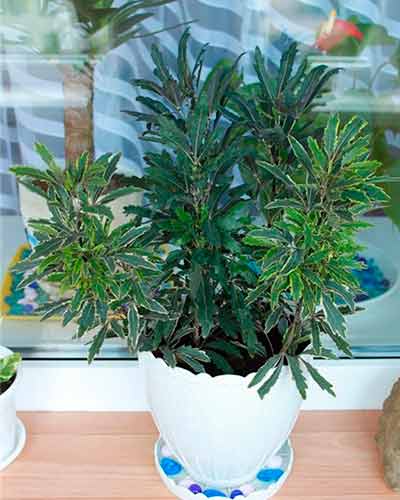

Dizigoteka is no less capricious to the humidity of the surrounding air. For its normal development, a moisture content of at least 60% is required. That is why spray it all year round with water several times a day, especially in the heat and during the heating season.
From mid-spring to mid-autumn, water the dizygotek abundantly, and in winter - moderately. Before the topsoil in the pot is completely dry, do not water. With insufficient watering, the leaves begin to dry out, and with excessive watering, the roots rot. Set up a drain at the bottom of the pot.
Transplanting a newly purchased dizigoteka
If the plant is bought ready-made in a planting container, this should be done in the summer. And always in sunny, warm and clear weather, focusing also on the conditions of the nursery or store where it was grown. This flower does not tolerate sudden changes in temperature, winds and drafts. Most often, you can find peat pots on sale in which three dizigoteka bushes are planted. They are filled with peat chips, so they should be transplanted at home after a short period of adaptation.
Earthen substrate is best purchased ready-made. Agricultural firms do not produce specialized soil for this asthenia, therefore, preference should be given to a composition close to the requirements for dracaena. It is fairly well aerated, and it is still recommended to add additional baking powder in the form of charcoal or vermiculite. Too dense soil quickly leads to the formation of root rot.
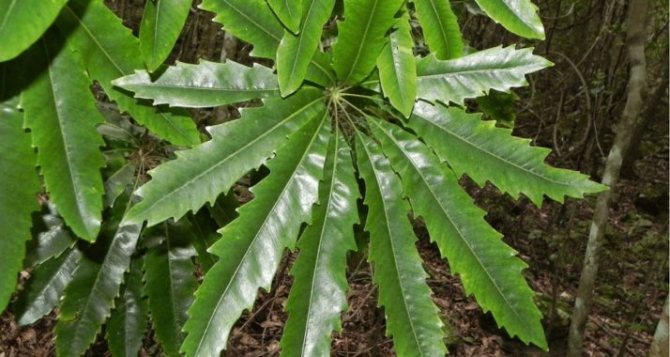

Main types
Within the group, several varieties of the dizigote can be distinguished:
- elegant... A small tree reaches 2 m in height. It is also distinguished by 30 cm leaves on long petioles with jagged leaf plates.
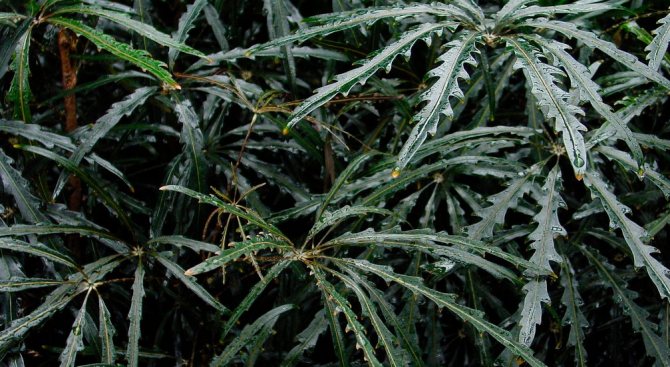

Within this species, 3 varieties are distinguished: desigoteca Bianca, Castor, Gemini;
- Veitch... This variety is very similar to the previous one. The main difference is the wider, but at the same time, short oval leaves;
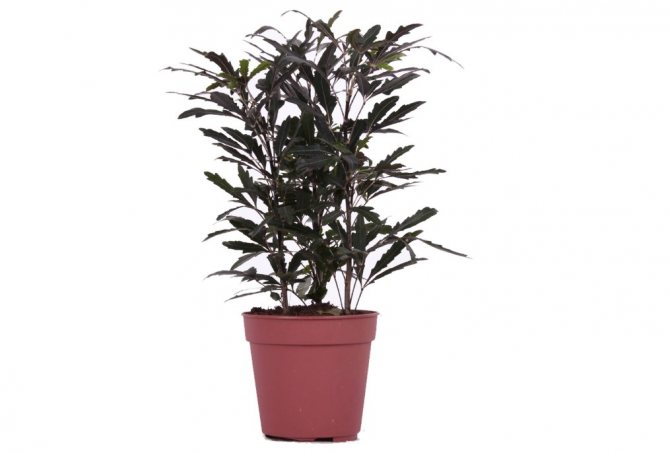

- Kerkhova... Dizigoteka has all the features of Veichi, but its leaves have a different shape and are colored in a slightly lighter shade;
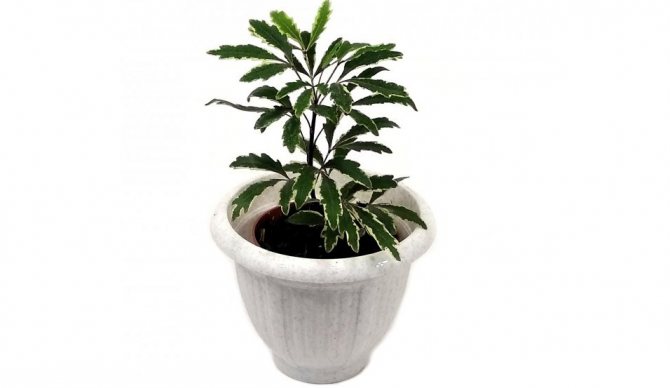

- Gracillima... The lowest among relatives; the edges of the wide leaves are wavy, the color is pale.
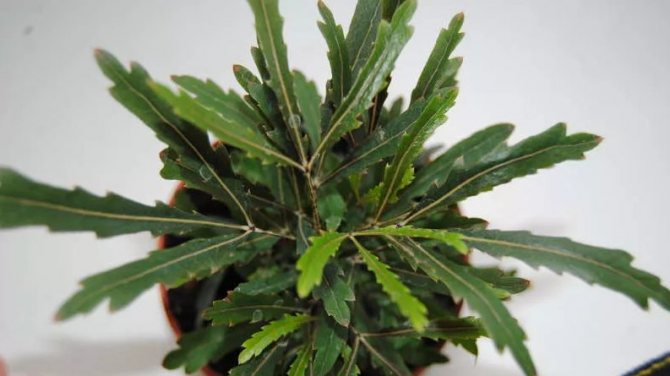

Did you know? Dizygoteka can hardly be called a popular plant, but it has better known relatives (for example, ginseng).
Reproduction of a houseplant dizigoteka from seeds
Dizygotek is propagated from seeds, which can be purchased at a flower shop. Not all growers manage to make the plant bloom at home, and even more so to tie the fruits with planting material. The seeds of the dizigoteka plant have high germination and do not lose it for several years. It reproduces as easy as shelling pears: at the end of winter, we prepare the substrate (peat + sand in equal amounts), sow, slightly deepening the planting material, moisten, cover with a transparent film and wait for the first shoots.
It is possible to dive plants during the reproduction of a dizigoteca by seeds at the stage of laying 2-3 leaves. There is another way - cuttings. It is suitable for those who already have such a plant or it is present in a friend's home collection. For cuttings, the apical shoots are cut and rooted in the same nutrient composition in which the seeds are germinated.
For a houseplant of a dizigoteca, an annual transplant into a new soil is recommended. The plant develops rapidly and absorbs nutrients. Young plants are transplanted into a more spacious container, they do not change in adults (a perennial develops well if its root system is cramped). Some growers plant 3-4 plants in one pot, it turns out not a bad composition. During transplantation, the capacity is made heavier, since the growing dizygoteka is able to turn it over. The plant is not demanding to the composition of the soil; universal or floral soil is suitable.
Description of the flower dizigoteka (with photo)
Starting the description of the dizigoteka flower, it is worth noting that there are 17 varieties of it in nature. Basically, the culture grows in the subtropics and tropical forests of Polynesia and New Caledonia. The plant is very rare and is listed in the Red Book in some countries. In home floriculture, these are variegated perennials with a very finicky character. The shoots of the dizigoteca are few, weakly branching. Most often, the stem is single, which makes the plant look like a small tree. Large leaves, cut into 4-12 lobes, grow on the stem in a spiral. The leaf plates are variegated, there are types and varieties of dizigotek with a spotted surface or a light outline. Finger lobes leathery to the touch, serrated at the edges and elongated oval.
Look at the dizigoteka flower in the photo, where all the characteristic species characteristics of this culture are presented:
During the flowering period, small nondescript buds are formed. They gather in umbellate inflorescences at the top of the trunks. After flowering, fruits appear - fleshy spherical berries of a dark brick color with numerous seeds.
Description of the plant
Dizygotheca is a low, tree-like, low-branching shrub or tree, rarely exceeding 1.5-2 m in height.In the wild areola, individual specimens reach 6-8 m, and the crown span can be more than 4 m.The plant has some resemblance to a palm tree , since a high, bare straight trunk is also crowned with a sweeping leaf cap.
Dizigoteca is cultivated exclusively because of the interesting finger-dissected leaves. Thanks to these elongated leaves, the flower looks extremely graceful. They are located on long thin spotted petioles with thickenings at the base. Shiny leathery leaf blades serrate or serrated along the edges, collected in 7-12 pcs. into a large, spreading umbrella-shaped branch.
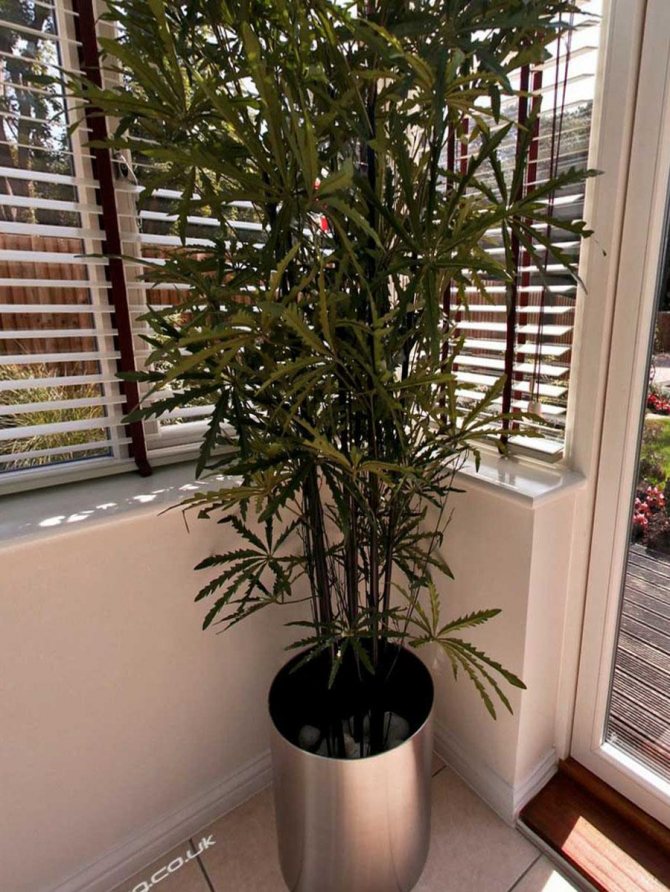

Segments 10-30 cm long have a color ranging from copper-reddish to dark brown and even almost black with pronounced veins of a contrasting shade. Petioles are light green, grayish with brown-brown specks, reddish at the very top.
The flowering of this plant is unremarkable, and the small apical umbellate inflorescences are often removed. Small buds of 5 pale greenish petals have a nondescript appearance. They open at the end of summer or at the very beginning of autumn. The fruit is a dark brownish-red rounded berry.
Conditions for successful growing at home
Dizigoteka graceful - a plant not suitable for a novice florist. Given its exotic origin, it requires special conditions in terms of temperature and humidity, which are difficult to achieve at home.
Location
In its natural environment, the flower lives in tropical forests, where direct sunlight does not reach, therefore, the dizygotek needs diffused lighting. It is especially important to make sure that at lunchtime, when the heat is at its peak, the pot with the plant is in the shade, where it is not threatened by sunburn.
Most often, such conditions are provided by the placement of a dizigoteka on the eastern and western windowsills, but the northern side may also be suitable.
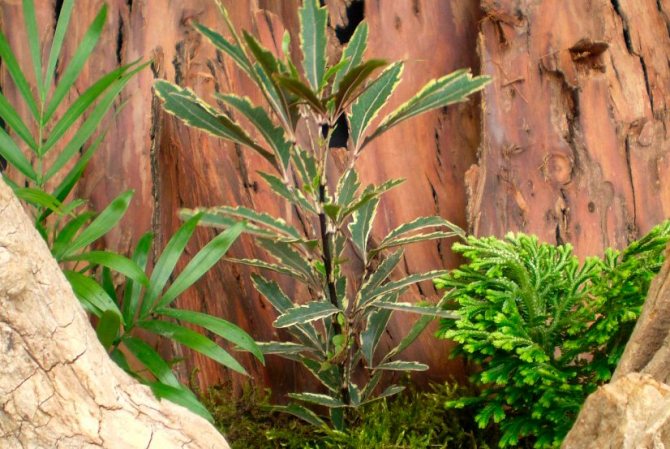

The summer also has its own peculiarities in the maintenance of the flower: when it is warm, you can take the flowerpot out into the fresh air in the shade. But in winter, when there is not enough natural light, and the temperature drops below +18 ° C, additional lighting with electrical appliances will not interfere.
Temperature
As for the temperature regime, there are a number of its own peculiarities:
- in summer the plant loves warmth - + 22 ... 27 ° С;
- in winter, the maximum temperature drop to the level of +15 ° С is permissible;
- during transition periods (spring / autumn), it can fluctuate within + 18 ... 20 ° С;
- you can not place a dizygotek near heating appliances;
- the development of the flower is negatively affected by sudden changes in temperature;
- protect the plant from drafts, otherwise the leaves may fall off, it is imperative.
Important! The dizigoteka feels best in a winter garden, where the temperature and humidity necessary for its comfort are maintained.
Air humidity
Humidity is another important factor in providing a suitable environment for the plant.
In the conditions of the European climate, it is difficult to achieve the indicators of tropical forests, so additional methods will come to the rescue:
- regular spraying with warm boiled or distilled water;
- placement in the florarium;
- using a pallet with wet pebbles or expanded clay, where you can put a flowerpot;
- fixing the flower pot above the water: fill a shallow (up to 3-5 cm), but spacious (at least 25-30 cm in diameter) vessel with liquid, and put pebbles in the center of it. Here and lower the pot.
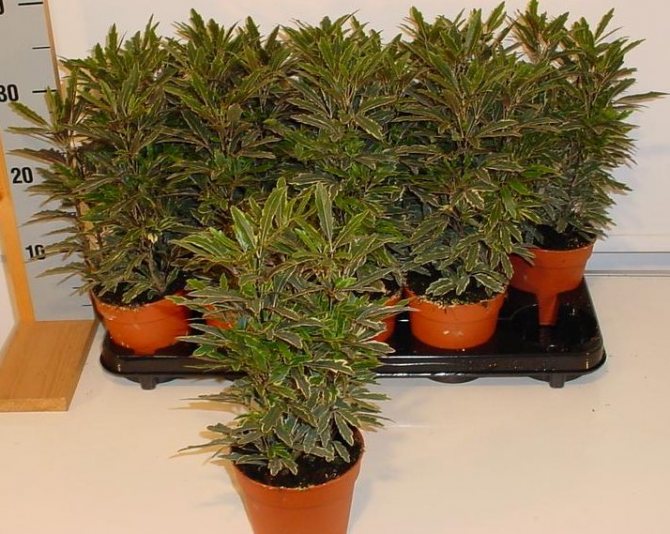

Growing difficulties
With improper care or uncomfortable living conditions, a dizigoteca can have various problems that slow down its growth and can lead to death.
Diseases
This plant does not suffer from diseases typical of indoor flowers, it has its own characteristic "weaknesses":
- if a dry, leaves fall, then the problem may be in the temperature regime of the room, the presence of drafts, dry air. It is necessary to check whether the plant is blowing from some side, increase the frequency of spraying or move the dizygotek to a warmer room;
- when roots rot, this is due to excessive watering. By cutting off the affected areas, treating them with charcoal so that rot does not spread to healthy ones, letting the flower dry out for a week or two before subsequent watering, you can save the plant. In the future, it is better to reduce the amount of liquid for regular watering;
Did you know? From Greek "dizigoteka" is translated as "two zygotes". This name arose due to the original form of the anther - in the form of double nests. - the plant can peel off the lower leavesif it doesn't have enough light. If a similar problem occurs, it is necessary to transfer the dizygotek to a lighter room (or compensate for the lack of natural light with the help of artificial light);
- light or brown spots indicate sunburn. In such cases, it is better to shade the plant;
- if a leaves wither, which means that you need to reduce the amount of liquid when watering;
- white marks on leaf plates indicate watering with hard water. The only way out is to use distilled or rainwater;
- if dizygoteka does not grow for a long time, produces only small leaves, then the plant suffers from a lack of fertilizer. An increase in the number of dressings will correct the situation.
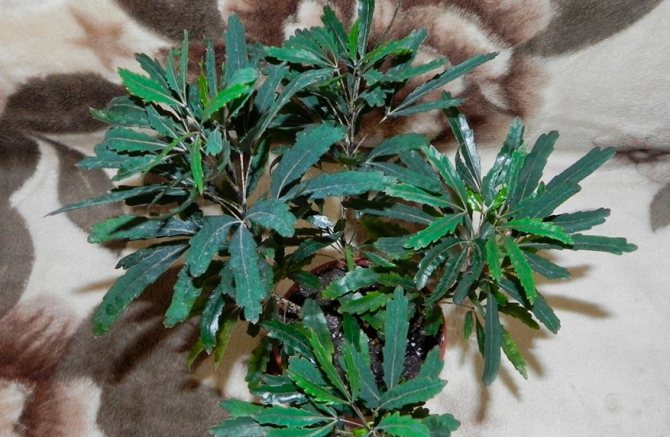

Pests
Dizygoteku can also be attacked by pests:
- shield;
- spider mite;
- thrips.
You can get rid of them by washing the leaves with soapy water or chamomile decoction. If there are too many pests, then you will have to treat the plant with insecticides ("Aktellik", "Decis", "Aktara").
The dizigoteka has a remarkable appearance. Indoor specimens bloom extremely rarely, but beautiful openwork leaves are enough, attracting the eye with their unusual shape. This flower is very demanding in terms of creating suitable conditions and proper care. This should be taken into account by those who want to acquire this plant at home.
Types and varieties
Most often, the most elegant dizygoteka (D. Elegantissima) is on sale with beautiful copper-red and dark green carved leaves.
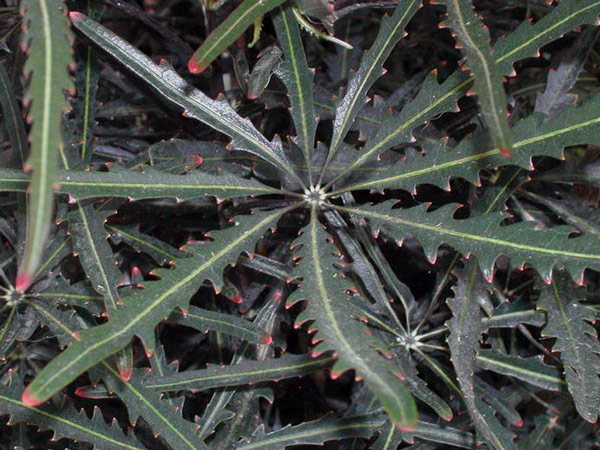

Dizigoteka the most elegant
Dizygoteca Veitch (Dizygo-theca veitchii) has wide leaves with wavy edges and not serrate.
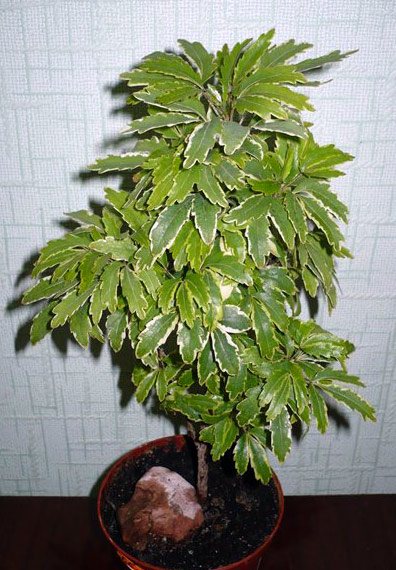

Dizigoteka
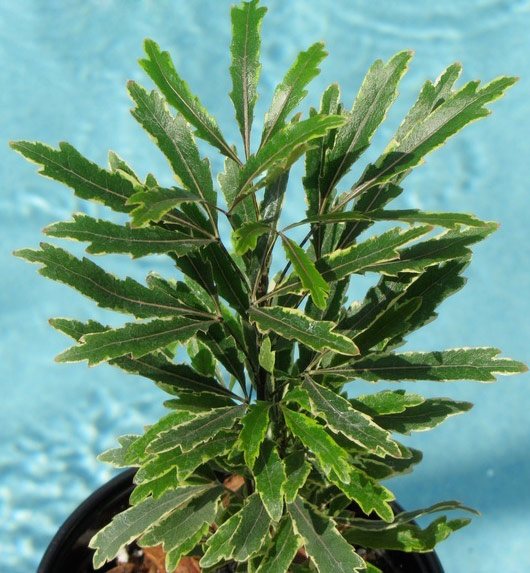

Dizigo photo
Dizigoteka Kerchova (D. kerchoveana) meets.
Varieties
In addition to traditional specimens, Plerandra elegantissima ‘Variegata’ is also available, a very original variety with a fairly compact cut and green leaves with a cream-white edge. The variety is very interesting, but not the only one. Among the traditional varieties worth mentioning is the popular Plerandra elegantissima 'Castor', compact, also with green leaves. Depending on your taste, you can choose an elegant dizigoteka that suits you.
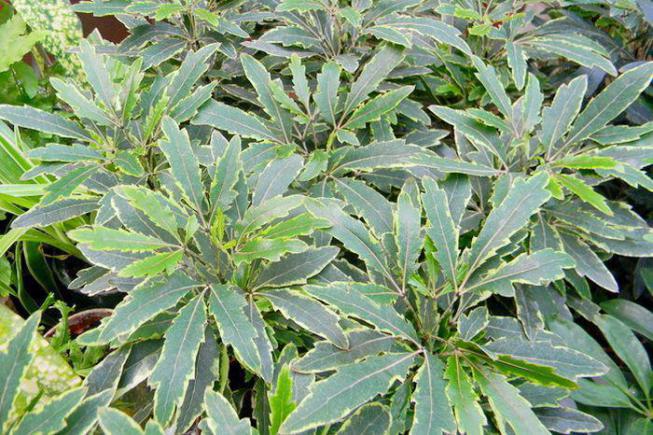

Soil mixture
Dizygoteka is not particularly demanding on soils, it will grow well in slightly alkaline and neutral soils.
It is preferable to plant this plant in a fertile and loose soil with a slightly acidic reaction (up to pH 6.5). From ready-made mixtures, compositions for dracaena and alocasia are suitable.
You can cook it yourself by taking 1 part of loose humus, 1 part of coarse river sand or vermiculite and 2 parts of leaf or forest sod land. This ratio is most similar to the soil in tropical undergrowth.
Such a light soil mixture perfectly permeates air, has a sufficient degree of water absorption, and also contains nutrients and nutrients necessary for the normal growth of plants. Some flower growers prefer to prepare a composition from peat, finely chopped sphagnum and turf, taken in equal proportions.
Dizigoteca transplant after purchase and in the process of growth
How to transplant a dizygotek photo
Transplant for the first time immediately after purchase, as the transport soil is mainly peat, which does not provide the plant with sufficient nutrition. The roots of the dizigoteca are tender, so use the transshipment method while preserving an earthen ball.
Traditionally, the transplant is carried out in the spring. Young trees will need an annual transplant with a pot change to a slightly larger diameter. The capacity should not be large, the root system of the dizigoteca should develop better in light oppression.
Adult specimens do not need to increase the volume of the pot, only renew the substrate. It is desirable to disturb them once every 2 years.

